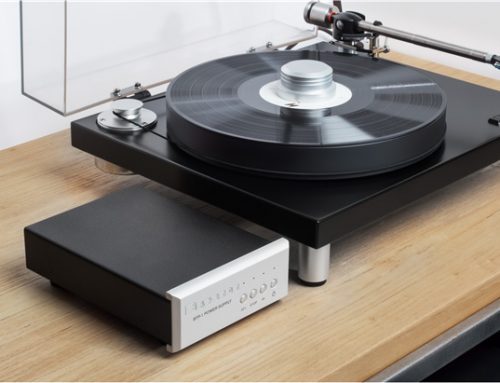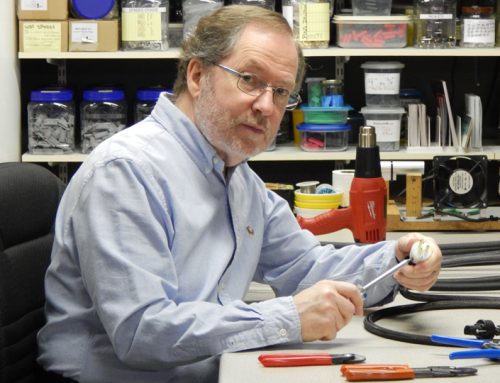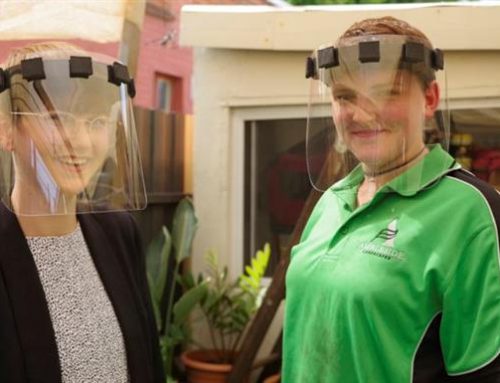
Mike Osadciw
Whether in a living room or a dedicated home theatre, movie lovers desire owning a large screen so that they can become immersed in their favourite films once the lights dim. We don’t want just a big picture – we want a big picture that looks as realistic as it can. The goal is to achieve a maximum entertainment experience while at the same time preserving the art of filmmaking and reproducing the picture as accurately as possible.
After spending some eleven years calibrating video displays, I’ve seen many diverse set-ups – some stellar and some, well, not so stellar. Based on these experiences, I have put together a few dos and don’ts when selecting a projector/screen combination and implementing it in a room. Existing projector owners and those considering buying a projector should find these tips equally valueable when trying to achive the best possible video performance.
What makes a great front projection picture?
a. maximum light output from projector after calibration
b. minimum/maximum viewing distances from the screen
c. resolution of projector/source material
d. screen surface selection
e. calibration and room environment
f. budget
Below I take a look at five common mistakes that can prevent a front projection picture from looking its best, and provide various solutions. Your room and video system components will determine which of these tips can be helpful for your particular setup.
Mistake #1: Going too big for the selected projector
Too many people choose projector screens blindly. It’s very easy to fall into the trap of wanting to go as big as the room will allow. But to achieve an optimal picture two important points must be considered when selecting a projector and screen size: 1) capable light output from the projector after calibration and 2) seating distance from the screen. In a front projection setup, the projector and screen work together to produce the picture.
Most retailers demonstrate and stock projectors in the $4K and under range. While these projectors are capable of amazing performance, they need to be matched with the correct screen size. The reality is that these “affordable” projectors are not capable of a lot of light output. In other words, their lamps may not be able generate enough light to create a bright picture. Light output is important because with the help of a good black level, it increases the contrast ratio (aka dynamic range) of the image. And a respectable dynamic range just happens to be high on the priority list for great video. A picutre with a good dynamic range should display dark blacks, bright whites (as well as picture details at both extremes) and provide a sense of three dimensionality. A good dynamic range will also help to achieve linear grayscale performance during a calibration process.
How does a projector with low light output affect the screen size choice? The bigger the screen, the larger the surface area the projector’s image has to fill. The consequence of choosing a screen that’s too big for a given projector is a compromised, dimmer image. If you currently have a projector setup, you can easily experiment to see how much brighter and sharper your picture gets if you use the lens to shrink the image size on your current screen. You may be amazed with how much brighter the image becomes.
As a rough guideline, a formula exists for calculating the footlamberts (fL, a unit of luminance) that a particular projector and screen combination will produce. The goal is to achieve a picture with at least 14 fL. The formula is:
ANSI Lumens of projector/square footage of screen = Footlamberts
Projector manufacturers will almost always provide a lumen specification for their projectors. However this advertised ANSI measurement is misleading because it never represents how the projector actually performs in most rooms; it does not take into account the screen size, screen material, and ambient light in the room. The above formula presumes the screen surface gain is 1.0 and after plugging in the numbers into the formula, the footlambert result will be far too high to be realistic in a home setting.
A more realistic lumens specification can sometimes be obtained in a projector review done by a qualified technician with proper equipment after the contrast control has been set correctly for usable light output (refer to what screen size and material they are using). This lumens value can be used for your own calculations but definitely don’t expect the results to be exact.
After finding an approximate ANSI lumens value, you will need to calculate the reflective surface area (length x width) of the diagonal screen size you are interested in. Make sure that all measurements are in the same units. As mentioned above, aim to achieve at least at 14 fL. A little lower is okay, but if you are much lower, you could multiply your fL result by a screen surface with a higher gain (such as 1.3). Alternatively you will need to reduce the size of the screen or consider a brighter projector. If you plan on permanently placing an anamorphic lens in front of the projector for 2.39:1 projection, you will need to consider that light output will drop even more.
In my experience, budget projectors from Panasonic, Epson, Sanyo, Mitsubishi, Sharp, and Sony all look great on 82″ screens and cap out at 92″. Going with a bigger screen will get you a bigger picture but one with less dynamic range and a less impressive overall picture. How can you solve this? Increase your budget and invest in a projector capable of more light output, and yes, this does mean leaving the $1000 to $4000 projector category and moving up. Even at higher price points one needs to be aware of how big to go. To get a bit more brightness, you could mount the projector at the closest throw distance it will allow, at the expense of a bit of lens distortion. You could also consider higher gain screen surfaces, but I don’t always recommend this route. Higher gain screens affect edge-to-edge uniformity (the picture will be brighter in the middle and darker at the sides), alter colour reproduction, and add glitter artifacts (yes, there are screens that sparkle). You will need to decide how much you want to compromise video quality for screen size. The WOW factor should include making bright images in your room.
Mistake #2: Sitting too close (or too far) from the screen
So you took the advice above and decided on an 92″ screen for a sharp, bright picture. You decided to sit 8 feet from the screen to get the widest viewing angle you think is acceptable (the angle from the centre of your eyes to the outside edges of the screen). Personal preference maybe, but… you see pixels and noise in the picture and you can’t get rid of them. You may have gotten the immersive experience you were hoping for, but sitting too close allows your eyes to see all of the 2 million-plus pixels that make up the 1080p picture. One of the goals of determining a proper seating distance is to produce a seamless image, so that you don’t see the individual pixels creating the image. Sitting further back, at about 13 feet, your eyes will do a better job of blending the pixels blending together, resulting in a better image. Don’t forget about the fill ratio of various technologies, too. Fill ratio, also known as the “screen door effect” is the ratio between actually image pixels and the gaps between the pixels. LCD projectors tend to have the least fill and the most gap (65% pixel, 35% gap) and LCoS have the best fill ratio (92%:8%). DLP is 85% to 15%.
How do you determine the best screen size in your room for 1080p resolution? Let’s consider a room in which your seat is 14 feet away from the screen. There are several recommended formulas and charts/calculators that can be found on the internet, which take into account the points above. If we follow SMPTE’s viewing arc recommendation of 30 degrees, and your seating area is fixed, the formula is:
viewing distance/1.626
This formula only applies to 16:9 screens with 1080p resolution and not the 2.39:1 ratio. It will give you a recommended diagonal screen size, which in this case works out to about 103″. Since screen sizes are sold using inches and often as diagonal measurements, it’s best to plug inches into the formula. If you already have a screen and you can move your seat forward or back, you can use this formula:
diagonal screen size*1.626
So if you have a 100 inch diagonal screen, multiply by 1.626 and your seat should be at 162.6 inches, or 13.6 feet from the screen. This is a recommendation although you can sit a bit closer and a bit further back when considering the factors of image envelopment, screen fill, and program resolution. For home theatres with multiple seating distances, you may want to consider the distances for other viewers. Figure 1 shows THX’s minimum and maximum recommended seating distances around the SMPTE specification and the optimum distance for 1080p systems and sources. If much of your programming is SD DVD, SD television, or HD broadcast, you may want to sit further away so these images look sharper. There are many artifacts in these lower resolution video signals not to mention the lack of real detail. How much detail you see in the image is directly related to how far back you are sitting from the screen. If you’ve followed this formula and it recommends a bigger screen than 92″, make sure to avoid mistake #1.

Mistake #3: Poor/misinformed screen surface choice
“I’ve painted the wall with a special formula some guy posted on a forum.” “They threw it in with the projector.” “Screens don’t make a difference.” “The sales guy told me it was the best.” These are just some of the comments I’ve heard from end users. But the fact is that the screen material can have a significant influence on the picture quality.
First of all, screens are environment specific. The reason we turn off the lights in a front projection home theatre is to enhance that ultra-important contrast ratio on the screen. Turn on the lights and the image becomes washed out and the contrast ratio is destroyed. Dark screen surfaces are used to enhance contrast ratios in bright room environments. The darker the screen, the darker the video black appears with light in the room. They are not without their trade-offs of colour fidelity and white field uniformity, but in an already compromised environment, we need to preserve contrast ratio first. In rooms where light can be controlled, low gain white screens are still preferred because of their superior colour and white field uniformity. Therefore a dark screen material in a dark theatre room is NOT recommended. On the flipside, there are screens such as the Stewart Filmscreen StudioTek 100 and Da-Lite JKP Affinity .9 which are designed for completely black room environments and are not recommended for rooms painted anything other than black. In a room painted with lighter tones, light scatter from the walls and ceiling will bounce back onto the screen and will compromise image quality.
Secondly, screens can compensate for particular projectors. I mentioned earlier that higher gain screens (1.5 and above) could compensate for a low light projector to give it the extra brightess boost. This will make the centre of the screen bright, the sides dimmer, and people sitting to the sides will see a darker image. Negative gain screens (gain below 1) were initially designed to deal with digital projectors that were far too bright and had absolutely terrible black levels and grayscale tracking. The screen was made to make a compromise that was acceptable but they could never correct the initial problems. Negative gain materials are still available today for extremely bright projectors (which is rare for most home theatre projectors) and some salespeople are too used to selling these materials by default. Just because they applied in the past it doesn’t mean they apply today. Most good quality home theatre projectors don’t need these screen coatings.
Mistake #4: Room environment/design not considered
Consider a room where the walls are light salmon, the ceiling is white and the floor has reflective tiles. The image is projected on the screen and the ceiling, walls and floor are lit up from the bright screen image. That bright reflection is then refleced back to the screen. You could just as well open up the curtains and allow sunlight to shine onto the screen! Of course under these conditions the image is washed out. Black level is raised and is no longer deep. Dynamic range is destroyed. These are just a few examples of how a room design can affect the on-screen image.
I recently calibrated a client’s home theatre which had the screen mounted very close to a white ceiling and the light scatter was terrible. By showing him a split video image (half 100% black, half 100% white), he saw how the light reflection from the ceiling caused the perceived black on the screen turn to light gray (See Figures 2 and 3 below). How does this relate to real video? Any bright part of the picture will completely wash out any dark part of the image. He immediately committed to painting the ceiling dark and continues to thank me ever since.


How do we solve this? Whether it is an existing or new room, choose to paint the surroundings with dark, neutral grays with no added colour (as colour from walls will affect the way we see colour on the screen far more than you may think). Black is best, particularly on the ceiling, although it may not be an option unless you have a dedicated home theatre room. The point is to minimize the amount of light boucing back to the screen because our eyes are very sensitive to a reduced dynamic range. I also recommend darkening around the projector lens with paint or a light-absorbing fabric such as Duvetyne. This will eliminate the earliest of reflections from the projector and, depending on where it is mounted, reduce stray light above the seating area.
Mistake #5: The image is not calibrated
If you’ve eliminated most of the mistakes mentioned above, you’re almost there. The final step to achieving the best possible picture is to have your projector properly calibrated to the screen, the viewing environment, and the rest of the video components in the system. Failing to do so, will result with a picture that contains a number of undesirable video artifacts. Since projection screens are very large, we are enlarging everything in the video signal (this includes all of the artifacts the projector itself is adding as part of its “enhancement” cicuits). A non-calibrated image can look too harsh, digital, noisy and unnatural. A properly calibrated image on the other hand will reward you with a picture that looks closest to how the film directors intended for it to be seen.
Projectors are machines that need to be tuned to work right. Yes, they do work directly out of the box, but would you drive a car without adjusting the seats, the mirrors and the steering wheel?
So why don’t projectors and TVs come calibrated out of the box? That’s because somewhere down the line manufacturers thought it was a good idea to change the picture as far away from what it’s supposed to look like, just to stand out from the competitors. Somewhere along the line they told you what you should see. And are they ever wrong!
I won’t get into all of the details of a calibration here and I’ll keep it related to front projection. Since you’ve now determined what projector, screen size and screen material you’ll be using, and what your room environment will look like, you need to now calibrate the projector to achieve its maximum dynamic range without losing essential detail. This is critical. The more the white level is pushed to the extreme, the greater the loss of detail in brighter parts of the image. Hence we use the term “usable contrast” because what good is making the picture brighter when 30 percent of the picture is missing as a result? If the selection of components was a good one, you should be close to the recommended digital projection brightness of 14 footlamberts (fL) or higher without losing detail. Adjusting grayscale will change this number as pulling blue out of white will lower the fL value. Balancing the grayscale and contrast/brightness controls for maximum performance is a technique that not all calibrators have mastered if they just follow the “routine steps” of calibration. Finding a well experienced and qualified video systems calibrator is just as important as selecting the right screen and projector.
What else is involved? Turning off all video-destroying circuits, setting gamma (rise out of black), sharpness, and CMS (Colour Management Systems) are things that a good calibrator will take the time and care to set with the correct measuring instruments. With the proper tools, and a detailed explaination, a typical projection calibration can take as long as 5 hours. Basic image controls are only a minor part of the calibration process and will not achieve an image representing the signal on the Blu-ray disc, DVD, or television signal coming through (all of which need to be calibrated to the display, which is the systems approach of calibration). The goal is to make your projection image follow the television standards identical to the monitors in the video mastering facilities. Why? Because film and video are two entirely different mediums that capture and display different information.
At home we live in a world of video. Colours captured on film are different than colours captured and reproduced on video. Filmmakers know this, and therefore every single film needs to be recoloured for home video release or else it will look wrong. New colour choices need to be made and these choices are made on calibrated monitors so filmmakers can accurately see the changes that will be released in the final product. This new image is then put on a Blu-ray disc for you to see at home on a calibrated display that follows the same rules. Video is moving art that needs to be seen as intended. Would you paint the Mona Lisa red?
Make a good picture, please!
Are you designing a dedicated room and not willing to compromise on image quality? Are you willing to make changes to your current environment to enhance the perfomance of what you already own? Follow as many of these suggestions as you can and you’ll be rewarded with an incredible picture that looks sharp, has deep blacks, bright whites and accurate colours. Now go pick up some new Blu-rays and enjoy them like never before!
Mike Osadciw
THX/ISF Professional Video Calibrator
HIGHEST FIDELITY CALIBRATIONS
thehighestfidelity@hotmail.com
905) 730-5996
14 Comments
Leave A Comment
You must be logged in to post a comment.






… [Trackback]
[…] Read More here to that Topic: novo.press/choosing-a-projector-and-screen-for-maxiumum-enjoyment/ […]
… [Trackback]
[…] There you can find 84981 more Information on that Topic: novo.press/choosing-a-projector-and-screen-for-maxiumum-enjoyment/ […]
… [Trackback]
[…] Info on that Topic: novo.press/choosing-a-projector-and-screen-for-maxiumum-enjoyment/ […]
… [Trackback]
[…] Read More on that Topic: novo.press/choosing-a-projector-and-screen-for-maxiumum-enjoyment/ […]
… [Trackback]
[…] There you can find 21440 additional Info on that Topic: novo.press/choosing-a-projector-and-screen-for-maxiumum-enjoyment/ […]
… [Trackback]
[…] Find More Info here on that Topic: novo.press/choosing-a-projector-and-screen-for-maxiumum-enjoyment/ […]
… [Trackback]
[…] Info on that Topic: novo.press/choosing-a-projector-and-screen-for-maxiumum-enjoyment/ […]
… [Trackback]
[…] Info on that Topic: novo.press/choosing-a-projector-and-screen-for-maxiumum-enjoyment/ […]
… [Trackback]
[…] Find More to that Topic: novo.press/choosing-a-projector-and-screen-for-maxiumum-enjoyment/ […]
… [Trackback]
[…] There you can find 35599 additional Info on that Topic: novo.press/choosing-a-projector-and-screen-for-maxiumum-enjoyment/ […]
… [Trackback]
[…] Read More here to that Topic: novo.press/choosing-a-projector-and-screen-for-maxiumum-enjoyment/ […]
… [Trackback]
[…] Read More on that Topic: novo.press/choosing-a-projector-and-screen-for-maxiumum-enjoyment/ […]
… [Trackback]
[…] There you will find 87211 more Info on that Topic: novo.press/choosing-a-projector-and-screen-for-maxiumum-enjoyment/ […]
… [Trackback]
[…] Read More Information here to that Topic: novo.press/choosing-a-projector-and-screen-for-maxiumum-enjoyment/ […]